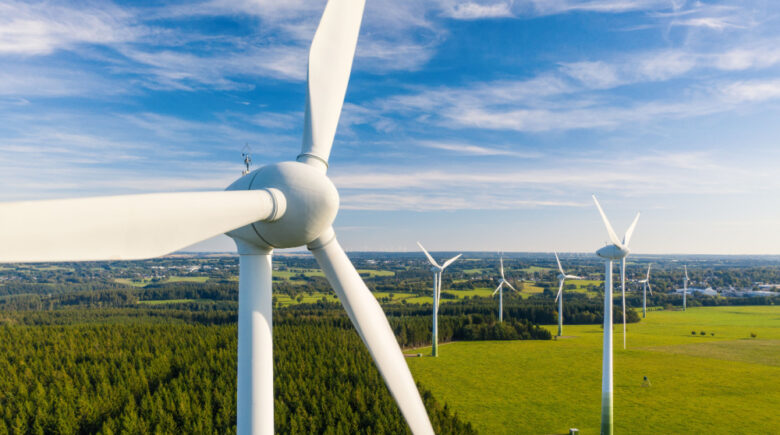Wind farms are a great way to generate sustainable and green energy for electricity. They do this by capturing the kinetic energy of wind to rotate turbines, which generate electricity via magnetic fields created by the movement of electric currents. This article will explore how wind farms work and the considerations of building one.
For a wind farm to be economically feasible, it needs prime conditions, including stable winds year-round and sufficient land space for standing towers and transmission lines. The time it takes between initial installation and harvesting of energy is around five years. Still, if a farm is done right, it can produce power until its scheduled decommissioning after 40 years. It’s good to know that the right wind farm can generate up to 100 megawatts of power, so funds for maintenance and turbines are much less than generated energy.
Given the ideal conditions, massive amounts of data must be gathered from meteorological information, such as atmospheric conditions and wind speed, to determine whether a specific location fits a wind farm. The general location is picked from satellite images which are then validated with tower data so that once the turbines are installed, they can capture as much energy as possible.
Field measurements like turbulence intensity and temperature preference must also be considered, so that turbine locations are chosen carefully.
Advantages of Wind Energy
1. Cheap
Wind energy is one of the cheapest forms of alternative energy there. For example, it doesn’t take much for a wind turbine to rotate, so it only takes a small wind speed to generate much power (think about how hard you had to pedal your bike on a flat surface). The structure required for modern wind farms is made of steel and concrete, both cheap materials. Also, the turbines don’t require constant maintenance, so they only need to be checked every three to five years.
2. Environmentally Friendly
The biggest draw toward using wind energy is that it is environmentally friendly. Wind farms are built in rural areas, so they don’t disrupt or disturb nearby communities or wildlife. The only byproduct of a wind farm is excess heat, used for nearby heating buildings, meaning less energy is needed for heating in an already rural area. Wind energy also doesn’t produce dangerous emissions, which means it’s safer than other forms of energy, such as coal and other fossil fuels.
3. Renewable Source
Wind energy is renewable and can continue to provide power for hundreds of years. The amount of energy produced by wind turbines is scalable, so the more wind farms installed, the more electricity is generated. Unlike traditional fossil fuel plants, wind generation does not use much water or produce greenhouse gases.
4. Zero Carbon Emissions
Wind energy is a zero-carbon emission energy source, meaning that it produces no greenhouse gases during its operation and has minimal impact on the environment. The turbine blades are made out of steel and concrete, but there’s no pollution besides a small amount of heat from the hair inside the generator. Also, wind farms don’t use up resources like water, so the only byproduct is excess heat.
The major benefit of wind farms that use windmills over those that use blades for power generation is that windmill generators generate less noise as they make less noise than turbines.
5. Easy to Install
The ease of installation makes windmills a great renewable source of energy. The only requirements are enough space to build the farm and a preexisting power grid to plug the power in. Compared to other forms of alternative energy, wind farms are straightforward, allowing larger portions of the world to use them easily.
6. Low Maintenance
Renewable energy is often more energy efficient than other energy sources. For example, wind farms only need to be serviced every three to five years, so they only require a little maintenance. In addition, they are extremely reliable and don’t require constant monitoring.
7. Portability
Windmills are easy to relocate so they can be placed in different locations based on existing power grids and surrounding environmental factors. They can also be scaled easily by adding more turbines or making them bigger, so it’s easy to build new wind farms even after the initial construction cost is paid off.
8. Efficient
The efficiency of wind turbine generators makes them a good choice for rural areas with access to sufficient water, and other fossil fuels need time to refine before usable energy is produced. However, if the wind farms are built in high-power demand locations, they may be less efficient since there needs to be more space to capture wind and generate power.
9. View from Above
Another advantage of windmills is that they look like giant blades from above, which can attract tourism and make people happy. The turbines seem relatively quiet even when the generator produces a decent amount of energy.
10. Local Job Creation
Wind energy is an attractive technology for deployment in remote rural areas with no electricity grids or high power demand. The wind turbines can be located in deserts, mountains, and forests, which offer ideal locations for farm operations.
Coupling wind energy with heterogeneous distributed generation (HVDC) transmission lines can help power large installations and integrate them into the grid. HVDC transmission lines transmit large amounts of power over very long distances. They offer better reliability and can provide additional grid security by allowing temporary disconnection of generators in far-flung remote locations without any loss of electrical output or load.
Altogether, wind energy is an excellent addition to any power grid. Compared to other renewable production methods, the wind is easier to install and maintain, cheaper, more environmentally friendly, and reliable. However, the major disadvantage of wind energy is that it isn’t a constant form of power generation which means that it requires backup sources when there isn’t enough wind. The average wind speed in many remote rural regions is high enough to create decent power. Wind energy is a pollution-free method of generating electricity, and it doesn’t require an extensive supply chain like traditional fossil fuel plants.
Wind farms are a great way to generate sustainable and green energy for electricity. They do this by capturing the kinetic energy of wind to rotate turbines, which generate electricity via magnetic fields created by the movement of electric currents. This article will explore how wind farms work and the considerations of building one.
For a wind farm to be economically feasible, it needs prime conditions, including stable winds year-round and sufficient land space for standing towers and transmission lines. The time it takes between initial installation and harvesting of energy is around five years. Still, if a farm is done right, it can produce power until its scheduled decommissioning after 40 years. It’s good to know that the right wind farm can generate up to 100 megawatts of power, so funds for maintenance and turbines are much less than generated energy.
Given the ideal conditions, massive amounts of data must be gathered from meteorological information, such as atmospheric conditions and wind speed, to determine whether a specific location fits a wind farm. The general location is picked from satellite images which are then validated with tower data so that once the turbines are installed, they can capture as much energy as possible.
Field measurements like turbulence intensity and temperature preference must also be considered, so that turbine locations are chosen carefully.
Advantages of Wind Energy
1. Cheap
Wind energy is one of the cheapest forms of alternative energy there. For example, it doesn’t take much for a wind turbine to rotate, so it only takes a small wind speed to generate much power (think about how hard you had to pedal your bike on a flat surface). The structure required for modern wind farms is made of steel and concrete, both cheap materials. Also, the turbines don’t require constant maintenance, so they only need to be checked every three to five years.
2. Environmentally Friendly
The biggest draw toward using wind energy is that it is environmentally friendly. Wind farms are built in rural areas, so they don’t disrupt or disturb nearby communities or wildlife. The only byproduct of a wind farm is excess heat, used for nearby heating buildings, meaning less energy is needed for heating in an already rural area. Wind energy also doesn’t produce dangerous emissions, which means it’s safer than other forms of energy, such as coal and other fossil fuels.
3. Renewable Source
Wind energy is renewable and can continue to provide power for hundreds of years. The amount of energy produced by wind turbines is scalable, so the more wind farms installed, the more electricity is generated. Unlike traditional fossil fuel plants, wind generation does not use much water or produce greenhouse gases.
4. Zero Carbon Emissions
Wind energy is a zero-carbon emission energy source, meaning that it produces no greenhouse gases during its operation and has minimal impact on the environment. The turbine blades are made out of steel and concrete, but there’s no pollution besides a small amount of heat from the hair inside the generator. Also, wind farms don’t use up resources like water, so the only byproduct is excess heat.
The major benefit of wind farms that use windmills over those that use blades for power generation is that windmill generators generate less noise as they make less noise than turbines.
5. Easy to Install
The ease of installation makes windmills a great renewable source of energy. The only requirements are enough space to build the farm and a preexisting power grid to plug the power in. Compared to other forms of alternative energy, wind farms are straightforward, allowing larger portions of the world to use them easily.
6. Low Maintenance
Renewable energy is often more energy efficient than other energy sources. For example, wind farms only need to be serviced every three to five years, so they only require a little maintenance. In addition, they are extremely reliable and don’t require constant monitoring.
7. Portability
Windmills are easy to relocate so they can be placed in different locations based on existing power grids and surrounding environmental factors. They can also be scaled easily by adding more turbines or making them bigger, so it’s easy to build new wind farms even after the initial construction cost is paid off.
8. Efficient
The efficiency of wind turbine generators makes them a good choice for rural areas with access to sufficient water, and other fossil fuels need time to refine before usable energy is produced. However, if the wind farms are built in high-power demand locations, they may be less efficient since there needs to be more space to capture wind and generate power.
9. View from Above
Another advantage of windmills is that they look like giant blades from above, which can attract tourism and make people happy. The turbines seem relatively quiet even when the generator produces a decent amount of energy.
10. Local Job Creation
Wind energy is an attractive technology for deployment in remote rural areas with no electricity grids or high power demand. The wind turbines can be located in deserts, mountains, and forests, which offer ideal locations for farm operations.
Coupling wind energy with heterogeneous distributed generation (HVDC) transmission lines can help power large installations and integrate them into the grid. HVDC transmission lines transmit large amounts of power over very long distances. They offer better reliability and can provide additional grid security by allowing temporary disconnection of generators in far-flung remote locations without any loss of electrical output or load.
Altogether, wind energy is an excellent addition to any power grid. Compared to other renewable production methods, the wind is easier to install and maintain, cheaper, more environmentally friendly, and reliable. However, the major disadvantage of wind energy is that it isn’t a constant form of power generation which means that it requires backup sources when there isn’t enough wind. The average wind speed in many remote rural regions is high enough to create decent power. Wind energy is a pollution-free method of generating electricity, and it doesn’t require an extensive supply chain like traditional fossil fuel plants.



